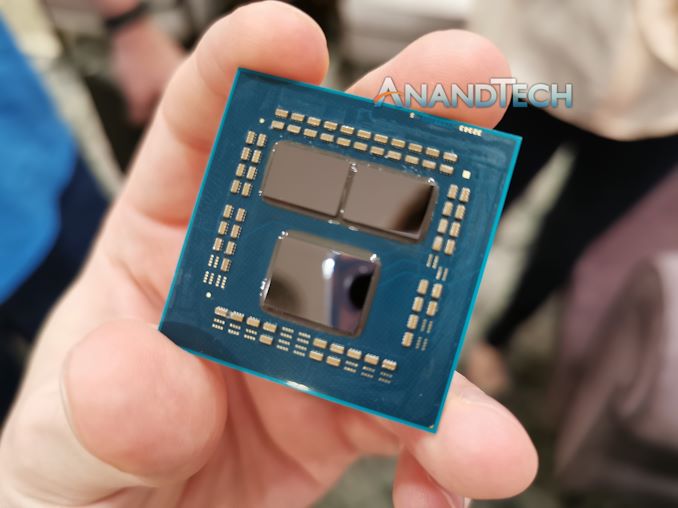Reaching for Turbo: Aligning Perception with AMD’s Frequency Metrics
by Dr. Ian Cutress on September 17, 2019 10:00 AM EST
For those that keep a close eye on consumer hardware, AMD recently has been involved in a minor uproar with some of its most vocal advocates about the newest Ryzen 3000 processors. Some users are reporting turbo frequencies much lower than advertised, and a number of conflicting AMD partner posts have generated a good deal of confusion. AMD has since posted an update identifying an issue and offering a fix, but part of all of this comes down to what turbo means and how AMD processors differ from Intel. We’ve been living on Intel’s definitions of perceived standards for over a decade, so it’s a hard nut to crack if everyone assumes there can be no deviation from what we’re used to. In this article, we’re diving at those perceived norms, to shed some light on how these processors work.
A Bit of Context
Since the launch of Zen 2 and the Ryzen 3000 series, depending on which media outlet you talk to, there has been a peak turbo issue with the new hardware. This turbo frequency issue has been permeating in the ecosystem since Zen 2 was launched, with popular outlets like Gamers Nexus noting that on certain chips, the advertised turbo frequency was only achieved under extreme cooling conditions. For other outlets, being within 50 MHz of the peak turbo frequency has been considered chip-to-chip variation, or a function of early beta firmware. A wide array of people put varying amounts of weight behind this, from conspiracy to not being bothered about it at all.
However, given recent articles by some press, as well as some excellent write-ups by Paul Alcorn over at Tom’s Hardware*, we saw that the assumed public definitions of processor performance actually differs from Intel to AMD. What we used as the default standard definitions, which are based on Intel’s definitions, are not the same under AMD, which is confusing everyone. No one likes a change to the status quo, and even with articles out there offering a great breakdown of what's going on, a lot of the general enthusiast base is still trying to catch up to all of the changes.
This confusion – and the turbo frequency discussion in general – were then brought to the fore of news in the beginning of September 2019. AMD, in a two week span, had several things happen essentially all at once.
- Popular YouTuber der8aur performed a public poll of frequency reporting that had AMD in a very bad light, with some users over 200 MHz down on turbo frequency,
- The company settled for $12.1m in a lawsuit about marketing Bulldozer CPUs,
- Intel made some seriously scathing remarks about AMD performance at a trade show,
- AMD’s Enterprise marketing being comically unaware of how its materials would be interpreted.
Combined with all of the drama that the computing industry can be known for – and the desire for an immediate explanation, even before the full facts were in – made for a historically bad week for AMD. Of course, we’ve reported on some of these issues, such as the lawsuit because they are interesting factoids to share. Others we ignored, such as (4) for a failure to see anything other than an honest mistake given how we know the individuals behind the issues, or the fact that we didn’t report on (3) because it just wasn’t worth drawing attention to it.
What has driven the discussion about peak turbo has come to head because of (1). Der8auer’s public poll, taken from a variety of users with different chips, different motherboards, different cooling solutions, different BIOS versions, still showed a real-world use case of fewer than 6% of 3900X users were able to achieve AMD’s advertised turbo frequency. Any way you slice it, without context, that number sounds bad.
Meanwhile, in between this data coming out and AMD’s eventual response, a couple of contextual discrepancies happened between AMD’s partner employees and experts in the field via forum posts. This greatly exacerbated the issue, particularly among the vocal members of the community. We’ll go into detail on those later.
AMD’s response, on September 10th, was a new version of its firmware, called AGESA 1003-ABBA. This was released along with blog post that detailed that a minor firmware issue was showing 25-50 MHz drop in turbo frequency was now fixed.
Naturally, that doesn’t help users who are down 300 MHz, but it does come down to how much the user understands how AMD’s hardware works. This article is designed to shed some light on the timeline here, as well as how to understand a few nuances of AMD's turbo tech, which are different to what the public has come to understand from Intel’s use of specific terms over the last decade.
*Paul’s articles on this topic are well worth a read:
Ryzen 3000, Not All Cores Are Created Equal
Investigating Intel’s Claims About Ryzen Reliability
Testing the Ryzen 3000 Boost BIOS Fix
This Article
In this article we will cover:
- Intel’s Definition of Turbo
- AMD’s Definition of Turbo
- Why AMD is Binning Differently to Intel, relating to Turbo and OC
- A Timeline of AMD’s Ryzen 3000 Turbo Reporting
- How to Even Detect Turbo Frequencies
- AMD's Fix











144 Comments
View All Comments
GeoffreyA - Wednesday, September 18, 2019 - link
Excellent article and detective work, Ian! Thank you for it. Also reminds me of observation in QM, where experiment affects the results. Anyway, have a great day.eva02langley - Wednesday, September 18, 2019 - link
"However, given recent articles by some press, as well as some excellent write-ups by Paul Alcorn over at Tom’s Hardware* "Please, I know you are parent sites, but HELL with that. Paul literally test the hardware with the SAME motherboard, the MSI GODLIKE x570 and never... ever mentioned anything close to a BIOS issue. He did an half-ass job that I could call as amateurish at best.
In the meantime, Steve from HardwareUnboxed tested the same CPU on DIFFERENT board and concluded into BIOS immaturity, what I called on the first instance of Toms series of bashing article.
ajlueke - Thursday, September 19, 2019 - link
I wouldn't necessarily agree, but the spirit of the statement is on track. In Paul Alcorn's write-up he attempted to associate the missing boost MHz, to a statement Shamino made about reliability, and then changes in thermal thresholds observed by "The Stilt".He never bothers to explain, why single threaded boosting (the thing everyone is complaining about) would be related to a threshold change from 80C to 75C when those temperatures are never observed during a lightly threaded workload. He then heats the boards up to those temps and looks at boosting, and sure enough, something changed just like the Stilt said. But what, if anything, does that have to do with the missing single thread boost MHz, when temps are well below 75C for most end users?
eva02langley - Wednesday, September 18, 2019 - link
" 1. Popular YouTuber der8aur performed a public poll of frequency reporting that had AMD in a very bad light, with some users over 200 MHz down on turbo frequency,2. The company settled for $12.1m in a lawsuit about marketing Bulldozer CPUs,
3. Intel made some seriously scathing remarks about AMD performance at a trade show,
4. AMD’s Enterprise marketing being comically unaware of how its materials would be interpreted."
And in the meantime in the same week...
1. https://www.extremetech.com/computing/297627-amd-o...
2. https://www.extremetech.com/computing/297785-amd-s...
Like I told AdoredTV... we have a very different definition of BAD WEEK. Honestly, those issue are hiccup of any new platform launch.
eva02langley - Wednesday, September 18, 2019 - link
"Others we ignored, such as (4) for a failure to see anything other than an honest mistake given how we know the individuals behind the issues, or the fact that we didn’t report on (3) because it just wasn’t worth drawing attention to it."The reason why you guys are pros. You didn`t do Intel dirty work for propagating their propaganda... unlike TomsHardware...
quadibloc - Wednesday, September 18, 2019 - link
Both Intel and AMD should start marketing their chips as "an X GHz chip", where X is the base frequency, if the turbo frequency isn't a part of the basic specirication of the chip that it must meet. Since even at the base frequency, apparently AMD chips don't last forever, it looks like I'm going to be underclocking mine a little.ballsystemlord - Wednesday, September 18, 2019 - link
Spelling and grammar corrections:"Certain parts of how the increased performance were understood,..."
Should be "was" not "were":
"Certain parts of how the increased performance was understood,..."
"...(standard is defined be Intel and AMD here, usually with a stock cooler, new paste, a clean chassis with active airflow of a minimum rate, and a given ambient temperature)..."
"by" not "be":
"...(standard is defined by Intel and AMD here, usually with a stock cooler, new paste, a clean chassis with active airflow of a minimum rate, and a given ambient temperature)..."
"This ultimately would lead some believe that this relates to a thermal capacity issue within the motherboard, CPU, or power delivery."
Missing "to":
"This ultimately would lead some to believe that this relates to a thermal capacity issue within the motherboard, CPU, or power delivery."
Uroshima - Thursday, September 19, 2019 - link
Very nice article.From what I understood, AMD has done tried to get as close to the limit of the silicon as possible regarding clocks. This allowed them to "survive" the transition to 7nm. Intel has kept a wide margin to the actual limits of the silicon and at 10nm (which is more or less 7nm of AMD) they struggle as the chips simply can't clock high enough.
Could be, this is the reason Intel will stick with 14nm for high performance until new silicon comes out that is similar to the AMD "to the limits" approach? This would be roughly 3 years from when they decided this (Jim Keller's arrival?).
I have a hunch that this is the future we are going towards, new nodes with diminishing returns (or even reductions) on clocks but advantages in power and number of transistors. Keeping close to the limit of the silicon will be the key for performance, right next to IPC.
On the other hand I would even consider that for some applications, having a refined 14* nm process could be an advantage (up to a frankenmonster of a hybrid 7/14 with UV). Intel, with its vast resources, should definitely explore this option to not only follow the competition but maintain the low thread performance crown.
But then, looks like AMD did their homework this time. :)
eva02langley - Thursday, September 19, 2019 - link
You are bang on. Intel 10nm process cost more, is having low yield and the frequency drop over 14nm++ is not bringing meaningful performances for making the transition.This is why Intel is releasing new server, laptop and desktop CPUs on 14nm++. It cost less, having better yield and perform better.
eva02langley - Thursday, September 19, 2019 - link
However the power consumption just cannot match TSMC 7nm.